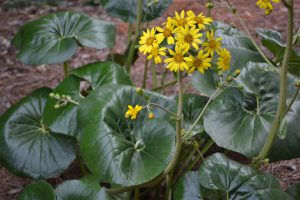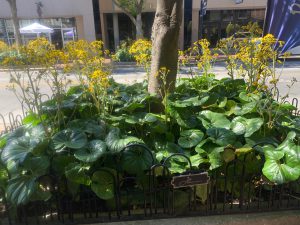Several years ago the Escambia County Master Gardener Volunteers added a Leopard plant, Farfugium japonicum to the office demonstration gardens. This was a new plant for me and I was immediately impressed with look and performance of this plant in a filtered shade garden.

Leopard plant’s attractive leaves and flowers make it an accent in the shade garden. Photo by Beth Bolles, UF IFAS Extension Escambia County.
Although not native to the United States, Leopard plant make an interesting addition to the Florida garden. The large green leaves can provide a tropical look throughout the entire year since it is hardy in growing zones 7-10. An added bonus of the Leopard plant are spikes of bright yellow flowers in the fall and winter months. When you use Leopard plant as a mass planting, it certainly becomes the focus in our cooler months.

Leopard plant on display in Downtown Pensacola. Photo by Beth Bolles, UF IFAS Extension Escambia County.
There are many cultivars of Leopard plant and the selections with white (‘Argenteum’) or yellow (‘Aureomaculatum’) patterns on the leaves give the plant it’s common name. There are also cultivars with curled or crinkled leaves. All plants will thrive in partial shade with some additional water when rainfall is lacking. The clumps will continue to enlarge so you can often share a piece with a friend after a few years.
- Video: Beach Sunflower is Not Just for the Beach - July 6, 2025
- Brightening Up A Shady Spot - June 20, 2025
- Video: Choosing the Best Location for a Southern Magnolia - May 22, 2025
